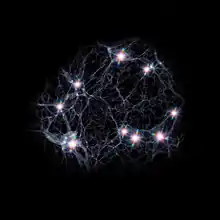Giant GRB Ring
The Giant GRB Ring is a ring of 9 gamma-ray bursts (GRBs) that may be associated with one of the largest known cosmic structures.[1] It was discovered July 2015[2] by a team of Hungarian and American astronomers led by L.G. Balazs while analyzing data from different gamma-ray and X-ray telescopes, in particular the Swift Spacecraft.[2]

The ring of GRBs lies at a distance of about 2.8 gigaparsecs (9.1 billion light years) from Earth at the redshift between 0.78 and 0.86[2] and measures about 1.72 gigaparsecs (5.6 billion light years) in diameter,[2] making it one of the largest structures known.[3]
Typically, the distribution of GRBs in the universe appears in the sets of less than the 2σ distribution, or with fewer than two GRBs in the average data of the point-radius system. Thus, such a concentration as this appears extremely unlikely, given accepted theoretical models. Proposals include the existence of a giant supergalactic structure. This would be an extremely huge structure of the universe, with a mean size of about 5.6 billion light years. Such a supercluster can explain the significant distribution of GRBs because of its tie to star formation. If such a structure did exist, it would be one of the largest structures of the observable universe.[4]
Discovery
In early July 2015, after the discovery of the Hercules-Corona Borealis Great Wall, I. Horvath, J. Hakkila and Z. Bagoly, among others, conducted a further detailed analysis of the spatial distribution of GRBs within the distant universe. Provided by more than 15 years of data from the Swift Gamma-Ray Burst Mission, amongst other ground-based telescopes, they assessed the data to see if any more structures can be seen using the method of GRB correlation. Suddenly, they noticed a significant clustering of GRBs within z = 0.78 - 0.86, with nine GRBs are concentrated in that region of 43 by 30 degrees of the sky.[5] With further tests and analysis of the clustering, they found out that the sample was indeed having a higher concentration than the expected normal level, indication of a massive galactic structure within the vicinity.[2]
Characteristics
The paper released by the team[2] did not show any data concerning the location of the structure. However, the distance and size was given. It is about 9.1 billion light years from Earth and about 5.6 billion light years across.[6]
See also
References
- Giant Mystery Ring of Galaxies Should Not Exist
- Balazs, L.G.; Bagoly, Z.; Hakkila, J.E.; Horvath, I.; Kobori, J.; Racz, I.I.; Toth, L.V. (2015-08-05). "A giant ring-like structure at 0.78 < z < 0.86 displayed by GRBs". Monthly Notices of the Royal Astronomical Society. 452 (3): 2236. arXiv:1507.00675. Bibcode:2015MNRAS.452.2236B. doi:10.1093/mnras/stv1421. Retrieved 5 August 2015.
- Robert Massey: 5 billion light years across: the largest feature in the universe. Royal Astronomical Society press release
- Five billion light years across: The largest feature in the universe
- Astronomers Discover Ring-Like Structure 5.6 Billion Light-Years Across
- The discovery.com article.
- Balázs, L. G.; Rejtő, L.; Tusnády, G. (21 January 2018). "Some statistical remarks on the giant GRB ring". Monthly Notices of the Royal Astronomical Society. 473 (3): 3169–3179. arXiv:1710.01621. Bibcode:2018MNRAS.473.3169B. doi:10.1093/mnras/stx2550.
- Pinter, S. (10 September 2018). "Multi‐messenger studies of γ‐ray bursts and their cosmic environment". Astronomische Nachrichten. 339 (5): 336–340. Bibcode:2018AN....339..336P. doi:10.1002/asna.201813501.